


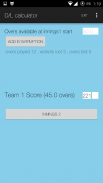

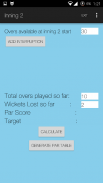
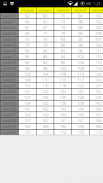
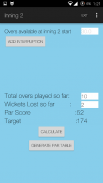
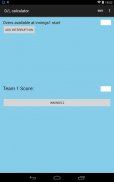
DL Calculator

Descrizione di DL Calculator
"The Duckworth–Lewis method is a mathematical formulation designed to calculate the target score for the team batting second in a limited overs cricket match interrupted by weather or other circumstances. It is generally accepted to be the most accurate method of setting a target score.
The basic principle is that each team in a limited-overs match has two resources available with which to score runs: wickets remaining, and overs to play. Where overs are lost, setting an adjusted target for the team batting second is not as simple as reducing the run target proportionally to the loss in overs, because a team with ten wickets in hand and 25 overs to bat can be expected to play more aggressively than if they had ten wickets and a full 50 overs, for example, and can consequently achieve a higher run rate. The Duckworth–Lewis method is an attempt to set a statistically fair target for the second teams innings, based on the score achieved by the first team, taking their wickets lost and overs played into account.The D/L method is not in direct proportion to the number of overs available to be faced, as with the average run rate method of correction. Instead they depend on how many overs are to go and how many wickets are down when the interruptions occur. "
"Il metodo Duckworth-Lewis è una formulazione matematica progettato per calcolare il punteggio stabilito per la seconda squadra battuta in una partita di cricket overs limitati interrotto da condizioni climatiche o altre circostanze. E 'generalmente accettato di essere il metodo più accurato di fissare un punteggio bersaglio.
Il principio di base è che ogni squadra in una partita limitata-over ha due risorse con cui piste punteggio: wicket rimanenti e overs per giocare. Dove overs sono persi, fissando un obiettivo rettificato per l'imbottitura squadra secondo non è così semplice come ridurre l'obiettivo corsa proporzionalmente alla perdita di overs, perché una squadra con dieci wicket in mano e 25 overs a pipistrello ci si può aspettare di giocare in modo più aggressivo che se avessero dieci wickets e ben 50 over, per esempio, e può quindi raggiungere un run rate più elevato. Il metodo Duckworth-Lewis è un tentativo di fissare un obiettivo statisticamente equo per il secondo inning squadre, in base al punteggio ottenuto dalla prima squadra, prendendo le loro wickets persi e over giocato in account.The D metodo / L non è in proporzione diretta al numero di overs disponibili da affrontare, come con il metodo della media tasso corrente di correzione. Invece dipendono da quanti overs sono andare e quante wickets sono giù quando si verificano interruzioni. "

























